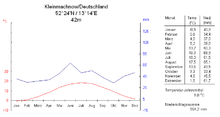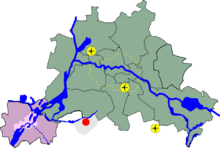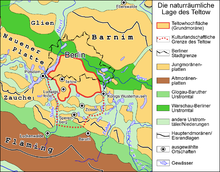Teltow
![]()
The title of this article is ambiguous. For other meanings, see Teltow (disambiguation).
Teltow ['tɛltoː, ![]() ] is the most populous town in the Potsdam-Mittelmark district of Brandenburg, with around 27,000 inhabitants. It is located directly on the southwestern outskirts of Berlin.
] is the most populous town in the Potsdam-Mittelmark district of Brandenburg, with around 27,000 inhabitants. It is located directly on the southwestern outskirts of Berlin.
The town of Teltow was first mentioned in a document by Margrave Otto III in 1265 and was also listed in the land register of Charles IV in 1375. Teltow's landmark is the town church of St. Andreas, located in the old town, whose origins date back to the 12th century. After the opening of the Teltow Canal in 1906, the small farming town developed into an industrial town. The people of Teltow also call their town "Rübchenstadt" after the Teltower Rübchen, a turnip that has been cultivated around Teltow for over 300 years.
After the reunification in 1990, the industrial and economic development and the importance as a residential town was promoted by the proximity to Berlin. Teltow's old town was largely redeveloped between 1994 and 2011 and has been fully listed since 1997.
Geography
Teltow is bordered to the north by the Teltow Canal, only at the bridge to Kleinmachnow does the city area protrude a small piece beyond the Teltow Canal to the north. The Berlin district ofSteglitz-Zehlendorf lies to the north, Großbeeren to the east and south, Stahnsdorf to the west and Kleinmachnow to the northwest. The distance from Teltow to Potsdam city centre is about 17 kilometres, that to Berlin-Mitte about 20 kilometres.
The total area of the city is divided into the following types of use:
| Total land area | Agricultural area | Forest | Water | Settlement and transport area |
| 2154 ha | 1039 ha | 159 ha | 33 ha | 820 ha |
| 100 % | 48,2 % | 7,4 % | 1,5 % | 38,1 % |
Geology
Teltow is located on the Teltow ground moraine plateau, which occupies the southwestern part of Berlin and the adjacent part of Brandenburg. This ground moraine was formed during the last ice age, the Weichsel ice age, about 21,000 years ago. In the Bäke valley, the water currents formed a particularly turbulent relief with small-scale chains of hills made of boulder clay and meltwater channels, which today are interspersed with puddles and pools. This relatively loose deposit from a geological point of view and the stream channel preformed by the Bäke made the construction of the Teltow Canal considerably easier. The canal follows the original Bäke almost completely.
The Buschgraben is a narrow glacial meltwater channel on the southwestern edge of Berlin. The southern part runs in a north-south direction between Berlin-Zehlendorf and Kleinmachnow and flows northwest of Teltow into the Teltowkanal. In Teltow there are two small water bodies, the Röthepfuhl and the Grimmspfuhl, which were formed from dead ice holes.
Climate
Teltow has a temperate climate, influenced by the Atlanticclimate from the north and west and the continental climate from the east. Weather extremes such as storms, heavy hail or above-average snowfall are rare.
The average annual precipitation of 551.2 mm is lower than the national average of about 800 mm. Most precipitation falls in the summer months from June to August with a peak of 69 mm in June. The lowest precipitation falls in October with 33 mm. The sun shines for an average of 1618 hours per year. The average annual temperature is 9.0 °C.

Climate diagram (nearest weather station Kleinmachnow)

Location at the city limits of Berlin

Natural situation of the Teltow
City breakdown
The district of Ruhlsdorf and the residential areas of Birkengrund, Seehof, Sigridshorst and Städtlersiedlung belong to the town of Teltow.
Search within the encyclopedia